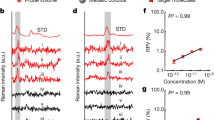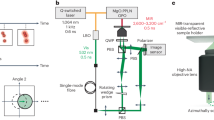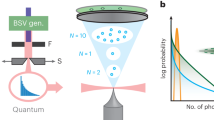Abstract
Lanthanide-doped upconversion nanoparticles (UCNPs) are promising single-molecule probes given their non-blinking, photobleaching-resistant luminescence on infrared excitation. However, the weak luminescence of sub-50 nm UCNPs limits their single-particle detection to above 10 kW cm−2, which is impractical for live cell imaging. Here, we systematically characterize single-particle luminescence for UCNPs with various formulations over a 106 variation in incident power, down to 8 W cm−2. A core–shell–shell (CSS) structure (NaYF4@NaYb1−xF4:Erx@NaYF4) is shown to be significantly brighter than the commonly used NaY0.78F4:Yb0.2Er0.02. At 8 W cm−2, the 8% Er3+ CSS particles exhibit a 150-fold enhancement given their high sensitizer Yb3+ content and the presence of an inert shell to prevent energy migration to defects. Moreover, we reveal power-dependent luminescence enhancement from the inert shell, which explains the discrepancy in enhancement factors reported by ensemble and previous single-particle measurements. These brighter probes open the possibility of cellular and single-molecule tracking at low irradiance.
This is a preview of subscription content, access via your institution
Access options
Access Nature and 54 other Nature Portfolio journals
Get Nature+, our best-value online-access subscription
$29.99 / 30 days
cancel any time
Subscribe to this journal
Receive 12 print issues and online access
$209.00 per year
only $17.42 per issue
Buy this article
- Purchase on Springer Link
- Instant access to full article PDF
Prices may be subject to local taxes which are calculated during checkout




Similar content being viewed by others
References
Auzel, F. Upconversion and anti-Stokes processes with f and d ions in solids. Chem. Rev. 104, 139–174 (2004).
Zhou, J., Liu, Q., Feng, W., Sun, Y. & Li, F. Upconversion luminescent materials: advances and applications. Chem. Rev. 115, 395–465 (2015).
Chen, G., Qiu, H., Prasad, P. N. & Chen, X. Upconversion nanoparticles: design, nanochemistry, and applications in theranostics. Chem. Rev. 114, 5161–5214 (2014).
Li, X., Zhang, F. & Zhao, D. Lab on upconversion nanoparticles: optical properties and applications engineering via designed nanostructure. Chem. Soc. Rev. 44, 1346–1378 (2015).
Wang, H.-Q., Batentschuk, M., Osvet, A., Pinna, L. & Brabec, C. J. Rare-earth ion doped up-conversion materials for photovoltaic applications. Adv. Mater. 23, 2675–2680 (2011).
Yang, D. et al. Current advances in lanthanide ion (Ln3+)-based upconversion nanomaterials for drug delivery. Chem. Soc. Rev. 44, 1416–1448 (2015).
Zheng, W. et al. Lanthanide-doped upconversion nano-bioprobes: electronic structures, optical properties, and biodetection. Chem. Soc. Rev. 44, 1379–1415 (2015).
Liu, J. et al. Ultrasensitive nanosensors based on upconversion nanoparticles for selective hypoxia imaging in vivo upon near-infrared excitation. J. Am. Chem. Soc. 136, 9701–9709 (2014).
Fischer, L. H., Harms, G. S. & Wolfbeis, O. S. Upconverting nanoparticles for nanoscale thermometry. Angew. Chem. Int. Ed. 50, 4546–4551 (2011).
Gargas, D. J. et al. Engineering bright sub-10-nm upconverting nanocrystals for single-molecule imaging. Nat. Nanotech. 9, 300–305 (2014).
Wu, S. et al. Non-blinking and photostable upconverted luminescence from single lanthanide-doped nanocrystals. Proc. Natl Acad. Sci. USA 106, 10917–10921 (2009).
Zhao, J. et al. Single-nanocrystal sensitivity achieved by enhanced upconversion luminescence. Nat. Nanotech. 8, 729–734 (2013).
Ma, C. et al. Optimal /sensitizer concentration in single upconversion nanocrystals. Nano Lett. 17, 2858–2864 (2017).
Liu, Y. et al. Amplified stimulated emission in upconversion nanoparticles for super-resolution nanoscopy. Nature 543, 229–233 (2017).
Nadort, A. et al. Quantitative imaging of single upconversion nanoparticles in biological tissue. PLoS ONE 8, e63292 (2013).
Wang, F. et al. Microscopic inspection and tracking of single upconversion nanoparticles in living cells. Light Sci. Appl. 7, 18007 (2018).
Liu, Q. et al. Sub-10 nm hexagonal lanthanide-doped NaLuF4 upconversion nanocrystals for sensitive bioimaging in vivo. J. Am. Chem. Soc. 133, 17122–17125 (2011).
Wang, G., Peng, Q. & Li, Y. Upconversion luminescence of monodisperse CaF2:Yb3+/Er3+ nanocrystals. J. Am. Chem. Soc. 131, 14200–14201 (2009).
Wang, F. et al. Tuning upconversion through energy migration in core–shell nanoparticles. Nat. Mater. 10, 968 (2011).
Vetrone, F., Naccache, R., Mahalingam, V., Morgan, C. G. & Capobianco, J. A. The active-core/active-shell approach: a strategy to enhance the upconversion luminescence in lanthanide-doped nanoparticles. Adv. Funct. Mater. 19, 2924–2929 (2009).
Chen, G. et al. (α-NaYbF4:Tm3+)/CaF2 core/shell nanoparticles with efficient near-infrared to near-infrared upconversion for high-contrast deep tissue bioimaging. ACS Nano 6, 8280–8287 (2012).
Zou, W., Visser, C., Maduro, J. A., Pshenichnikov, M. S. & Hummelen, J. C. Broadband dye-sensitized upconversion of near-infrared light. Nat. Photon. 6, 560–564 (2012).
Chen, X., Peng, D., Ju, Q. & Wang, F. Photon upconversion in core–shell nanoparticles. Chem. Soc. Rev. 44, 1318–1330 (2015).
Wang, F., Wang, J. & Liu, X. Direct evidence of a surface quenching effect on size-dependent luminescence of upconversion nanoparticles. Angew. Chem. Int Ed. 49, 7456–7460 (2010).
Johnson, N. J. et al. Direct evidence for coupled surface and concentration quenching dynamics in lanthanide-doped nanocrystals. J. Am. Chem. Soc. 139, 3275–3282 (2017).
Fischer, S., Bronstein, N. D., Swabeck, J. K., Chan, E. M. & Alivisatos, A. P. Precise tuning of surface quenching for luminescence enhancement in core–shell lanthanide-doped nanocrystals. Nano Lett. 16, 7241–7247 (2016).
Wu, D. M., García-Etxarri, A., Salleo, A. & Dionne, J. A. Plasmon-enhanced upconversion. J. Phys. Chem. Lett. 5, 4020–4031 (2014).
He, J. et al. Plasmonic enhancement and polarization dependence of nonlinear upconversion emissions from single gold nanorod@SiO2@CaF2:Yb3+,Er3+ hybrid core–shell–satellite nanostructures. Light Sci. Appl. 6, e16217 (2017).
Damasco, J. A. et al. Size-tunable and monodisperse Tm3+/Gd3+-doped hexagonal NaYbF4 nanoparticles with engineered efficient near infrared-to-near infrared upconversion for in vivo imaging. ACS Appl. Mater. Interfaces 6, 13884–13893 (2014).
Burgess, A. E. The Rose model, revisited. J. Opt. Soc. Am. A 16, 633–646 (1999).
Cheezum, M. K., Walker, W. F. & Guilford, W. H. Quantitative comparison of algorithms for tracking single fluorescent particles. Biophys. J. 81, 2378–2388 (2001).
Xiong, L. Q. et al. High contrast upconversion luminescence targeted imaging in vivo using peptide-labeled nanophosphors. Anal. Chem. 81, 8687–8694 (2009).
Boyer, J. C. & van Veggel, F. C. Absolute quantum yield measurements of colloidal NaYF4:Er3+,Yb3+ upconverting nanoparticles. Nanoscale 2, 1417–1419 (2010).
Acknowledgements
S.C. acknowledges financial support from the Moore Foundation (no. 4309) and the Stanford Neurosciences Institute (no. 119600). TEM and SEM imaging were performed at the Stanford Microscopy Facility (National Institutes of Health grant SIG number 1S10RR02678001). EDX mapping and high-resolution TEM were performed at the TEM facility of Nanjing University of Posts and Telecommunications. The authors thank A. Brunger, E. Chan, B. Cohen, J. Collins, J. Dionne, D. Jin and X. Liu for helpful discussions.
Author information
Authors and Affiliations
Contributions
Q.L., Y.Z., C.S.P., T. Y. and L.-M.J. were responsible for the experimental work. Q.L., Y.Z., C.S.P. and S.C. conceived the project. S.C. supervised the research. All authors discussed the results. The manuscript was written by Q.L., Y.Z., C.S.P. and S.C.
Corresponding author
Ethics declarations
Competing interests
The authors declare no competing interests.
Additional information
Publisher’s note: Springer Nature remains neutral with regard to jurisdictional claims in published maps and institutional affiliations.
Supplementary information
Supplementary Information
Material synthesis and characterization; Supplementary References 1–6; Supplementary Figures 1–20; Supplementary Tables 1–2.
Rights and permissions
About this article
Cite this article
Liu, Q., Zhang, Y., Peng, C.S. et al. Single upconversion nanoparticle imaging at sub-10 W cm−2 irradiance. Nature Photon 12, 548–553 (2018). https://doi.org/10.1038/s41566-018-0217-1
Received:
Accepted:
Published:
Issue Date:
DOI: https://doi.org/10.1038/s41566-018-0217-1
This article is cited by
-
Tumor-associated antigen-specific cell imaging based on upconversion luminescence and nucleic acid rolling circle amplification
Microchimica Acta (2024)
-
Bright single-nanocrystal upconversion at sub 0.5 W cm−2 irradiance via coupling to single nanocavity mode
Nature Photonics (2023)
-
Phonon-assisted upconversion in twisted two-dimensional semiconductors
Light: Science & Applications (2023)
-
Enabling efficient NIR-II luminescence in lithium-sublattice core—shell nanocrystals towards Stark sublevel based nanothermometry
Nano Research (2023)
-
Investigation of Upconversion Luminescence Attenuation in Aqueous Solutions Under 980 nm and 808 nm Irradiation
Journal of Analysis and Testing (2023)



